Nursing Assignment With Solution Sample Assignment
Question 1
Nano Tech is ready to begin production of its exciting new technology. The company is evaluating three methods of production: (A) a small production facility with older equipment, (B) a larger production facility that is more automated, and (C) subcontracting to an electronics manufacturer in Singapore. The costs of each alternative are shown below. Deter- mine for what level of demand each production process should be chosen.
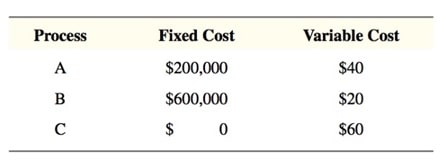
Solution:
Total Cost of Subcontracting = Total Cost Small Facility
$60 × X = $200,000 + $40 × X
$20 × X = $200,000
X = 10,000
Total Cost of Small Facility = Total Cost Larger Facility
$200,000 + $40 × X = $600,000 + $20 × X
$20 × X = $400,000
X = 20,000
Subcontract if demand is less than 10,000 items. Use larger facility when over 20,000 items are needed. Otherwise, use small facility.
Question 2:
1. Trace the path of the medication list and denote possible failure points. Construct a process flowchart of the existing process and create a new chart of an improved process.
Answer
The medication list was produced by the nursing home and give to the ambulance driver. The ambulance driver either misplaced the list or gave it to the wrong person. The client rewrote the medication list and presented it to the emergency room who faxed it but it was unreadable. The client prepared another list and submitted one copy to the nurse, another on his dad’s bulletin board and another for himself. The list was then submitted to the nursing station. The possible points of failure that caused a breakdown in communication include:
- The ambulance driver
- Emergency room
The figure below shows the flow of the existing process.
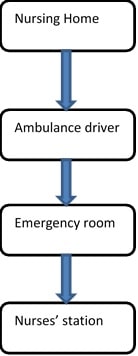
The process flow can be improved and depicted as shown in the chart below:
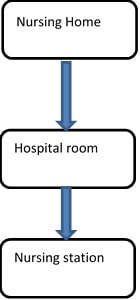
2. Was the medication error a failure of individuals or a failure of the process? Explain.
Answer
The medication error was as a result of individuals. The particular individuals that caused this error were the ambulance driver and the nurses in the emergency room. The failure of the ambulance driver to deliver the medication list was the beginning of the series of errors. The nurses at the emergency room failed to update the list in time and prepared an illegible fax. The nurses at the hospital administered a wrong medication which was dated 2 years ago.
3. Think about the different settings: the ambulance, the emergency room, the hospital room, and the nurse’s station. How is data handled in each setting? Can the process of recording information be changed so that everyone is using the same data? How can the accuracy of the data be assured?
Answer
- The ambulance: Data is handled manually. The ambulance driver is given data that he is supposed to deliver by hand.
- The emergency room: Data handling is computerized and is updated on computer system. It can also be received through faxing.
- The hospital room: Data handling is manual.
- The nurse’s station: Data handling is computerized and is normally updated online.
The system of data can be changed so that there can be harmony in the type of data used by all persons. Data should be computerized at the nurses’ station so that there no need for hand delivery by the ambulance driver. The accuracy of the data can be assured by eliminating the points of failure in the process.
4. Given Melanie’s reaction, do you think this error will happen again? Why or why not?
Answer
Melanie’s reaction does not assure us that this will not happen again. The fact that she did not seem very concerned about the incident and also dismissed the client hurriedly only promising to take action later indicates that there is a possibility that nothing might change in the entire process.
Question 3:
The Henry Street Mission uses volunteers to assemble care packages for needy families during the holiday season. The mission would like to organize the work as efficiently as possible. A list of tasks, task times, and precedence requirements follows:
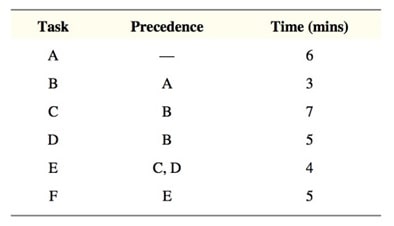
1. If the mission wants to complete a care package every 10 minutes, how many volunteers should be called in? Balance the line and calculate the efficiency. How many packages can be assembled in a four-hour period?
2. Suppose that volunteers are plentiful. Balance the line to maximize output. What is the efficiency of the line? How many care packages can be assembled in a four-hour period?
Solution:
1. First, we draw a precedence diagram. Element A has no elements preceding it, so node A can be placed anywhere. Element A precedes element B, so the line segment that begins at node A must end at node B. Element B precedes element C. Again, a line segment from node A must end at node C. Elements C and D precede element E, so the line segments extending from nodes C and D must end at node E. The precedence diagram is completed by adding the time requirements beside each node. Element E node must end at E.
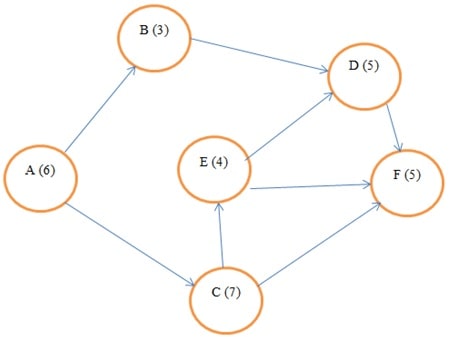
We calculate the desired cycle time and the theoretical minimum number of worker:
N = 6 + 3 + 7 + 5 + 4 + 5 / 10 = 3
2. Total minutes produced by the line: To get total produced minutes multiply production pieces by SAM. Total minutes attended by the all operators in the line: Multiply number of operators by daily working hours and convert total hours into total minutes (multiplying by 60).
In a four hour period
4 × 60 = 240
Now, calculate line efficiency using following formula:
Line efficiency (in percentage) = Total minutes produced by the line × 100 / total minutes attended by all operators
So,
30 × 100 / 10 = 300
Question 5
Given the following network and probabilistic activity time estimates, determine the expected time and variance for each activity and indicate the critical path:
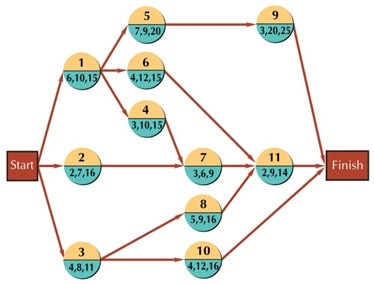
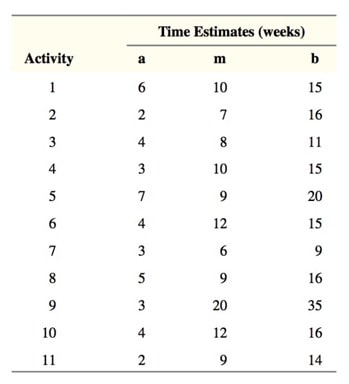
Solution:
|
Activity |
a |
m |
b |
Expected Time |
Variance |
|
1 |
6 |
10 |
15 |
9.16 |
2.25 |
|
2 |
2 |
7 |
16 |
7.66 |
5.44 |
|
3 |
4 |
8 |
11 |
7.83 |
1.36 |
|
4 |
3 |
10 |
15 |
9.66 |
4.00 |
|
5 |
7 |
9 |
20 |
10.50 |
4.69 |
|
6 |
4 |
12 |
15 |
11.16 |
3.36 |
|
7 |
3 |
6 |
9 |
6.00 |
1.00 |
|
8 |
5 |
9 |
16 |
9.50 |
3.36 |
|
9 |
3 |
20 |
35 |
19.66 |
28.44 |
|
10 |
4 |
12 |
16 |
11.33 |
4.00 |
|
11 |
2 |
9 |
14 |
8.66 |
4.00 |
Working:
Expected Duration = T e = a + 4m + b ÷ 6
= T e = 6 + 4(10) + 15 ÷ 6
= T e = 9.16 as all remaining
Variance = V =σ2 = [t b - ta ÷ 6]2
= V =σ2 = [15 - 6 ÷ 6]2
V =σ2 = 2.25 as all remaining
Critical Activities: 4, 7, 10, 11 are the critical activities of this network
Question 6:
The following table provides the information necessary to construct a project network and project crash data:
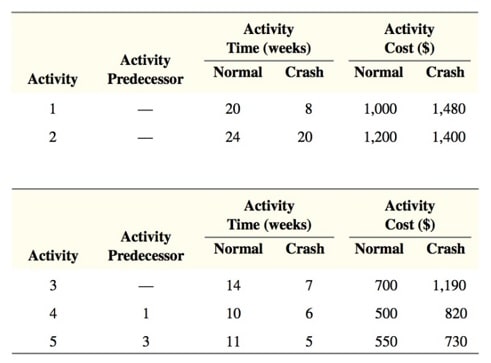
- Construct the project network.
- Determine the maximum possible crash time for the network, and crash the network the maximum amount possible.
- Compute the normal project cost and the cost of the crashed project.
Solutions:
Activity Time:
|
Activity |
Activity Predecessor |
Normal Time (weeks) |
Crash Time (weeks) |
|
1 |
- |
20 |
8 |
|
2 |
- |
24 |
20 |
|
3 |
- |
14 |
7 |
|
4 |
1 |
10 |
6 |
|
5 |
3 |
11 |
5 |
Let 1 = Activity A; 2 Activity B; 3 = Activity C; 4 = Activity D; 5 = Activity E
A.
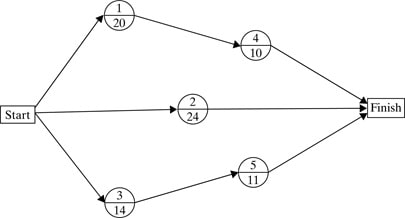
B. Critical path (before any crashing): 1 4
Normal critical path time: 30 weeks
Crash critical path: 2
Maximum possible project crash time: 20 weeks
|
Activity |
Activity Predecessor |
Normal Time (weeks) |
Crash Time (weeks) |
Normal Cost |
Crash Cost |
|
1 |
- |
20 |
8 |
$1000 |
$1480 |
|
2 |
- |
24 |
20 |
$1200 |
$1400 |
|
3 |
- |
14 |
7 |
$700 |
$1190 |
|
4 |
1 |
10 |
6 |
$500 |
$820 |
|
5 |
3 |
11 |
5 |
$550 |
$730 |
C.
|
Activity |
Normal Time (weeks) |
Crash Time (weeks) |
Normal Cost |
Crash Cost |
Max Time reduction |
Crash cost (per week saved) |
|
1 |
20 |
8 |
$1000 |
$1480 |
12 weeks |
$40 |
|
2 |
24 |
20 |
$1200 |
$1400 |
4 weeks |
$50 |
|
3 |
14 |
7 |
$700 |
$1190 |
7 weeks |
$70 |
|
4 |
10 |
6 |
$500 |
$820 |
4 weeks |
$80 |
|
5 |
11 |
5 |
$550 |
$730 |
6 weeks |
$30 |


